3
High Speed Transducer
Place the nylon washer over the opposite end of the headed pin. Place the stainless
washer over the 1/4--20 x 5/8” screw threads, then insert into the opposite end of
the headed pin and finger tighten only. The screw has a thread locking
compound on the threads to prevent loosening, and should not be fully
tightened until all adjustments are made.
Running Position Adjustment
The running position of the transducer is now completely adjustable. Subsequent
adjustment may be necessary to tweak the installation after high speed testing. The
metal bracket allows height and tilt adjustment; the pivot screws allow angle adjustment.
Adjust the angle of the transducer body first, so it is parallel with the hull of the boat, and fully
tighten the two pivot screws using the supplied Allen wrench. Access to the pivot screws is
provided by the lower holes in the side of the mounting bracket.
Next, adjust the height of the assembly so the face of the transducer is 1/8” (3 mm) to 1/4”
(6 mm) beneath the bottom of the transom, and fully tighten the three mounting screws.
In order to gain access to the mounting screws, the transducer assembly must be pivoted up
into the bracket as shown. Be careful not to alter the running angle as some force is necessary
to pivot the assembly.
If access to the top mounting hole is not possible due to the selected height of the transducer,
fully tighten the two lower screws. Remove the headed pivot pin and the transducer
assembly, tighten the top screw, and then reassemble.
Finally, ensure that all mounting screws are fully tightened.
Routing the Cable
The transducer cable has a low-profile connector that must be routed to the point where the
fishfinder is mounted. Every boat is different and there may be several ways to route the
cable (see the illustration on the following page).
If you choose to pass the cable through the transom of the boat, a 5/8” (16 mm) hole must
be drilled above the waterline. Fill this hole with silicone sealant, and use the supplied
escutcheon plate to dress the entry hole. This will require two #8 x 5/8” (16 mm) screws and
drilled holes of 9/64” (3.6 mm).
Remember that the transducer can pivot 90 degrees in the bracket should an object be struck,
and make sure sufficient cable slack exists for this movement. It is best to route the cable to
the side of the transducer so the cable will not be damaged by the rotating transducer.
Cable clamps are provided to secure the cable to the transom, and use the same type of
screws as the escutcheon plate.
Inside the boat, there is often a channel or conduit which is used for other wiring, which can
be used to route the transducer cable forward. Avoid routing the cable in areas where it may
be damaged or may interfere with normal boating operations. The transducer cable should
not be cut or shortened, and care should be used not to damage the cable insulation. Also,
be sure to route the cable as far as practical from the antenna cable of VHF radios to reduce
the possibility of interference.
Attaching the pivot to the bracket
Tighten the Pivot Screws
Tighten the Mounting Screws
Hand Tighten Only





